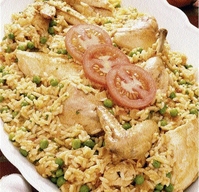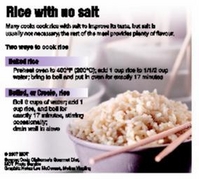
Rice can be served separately as part of all-in-one meals.
Did you know that rice is grown on every continent of the world except Antarctica? Rice has become a staple of many diets around the world and, in the chain of supply and demand, hundreds of kinds of rice are grown. Rice is an essential staple and in some languages the word 'eat' means 'to eat rice'. Most of the world eats white rice over brown rice.
Selecting rice from a supermarket shelf can be quite confusing if you do not know what to look for. Despite the wide variety of rice, they are broken down into categories - Japonica, rice that sticks together; and Indica, rice that is dry and separate.
What makes them different is the proportion of starches, amylopectin and amylase in each. Japonica has a large amount of amylopectin, a sticky starch found in medium- and short-grain rice. When this category of rice is cooked, it has a soft, clinging consistency and is able to absorb the flavours of other ingredients.
Long-grain rice

Long-grain rice is from the Indica group and high in amylase, a dry, non-waxy starch, causing rice to cook into firm, dry, separate grains. All long-grain rices have the same general characteristics.
Long grains are slender and three to five times as long as they are wide. When cooked, long-grain rice stays dry, separate and fluffy. Examples of long-grain rice are Basmati and Jasmine, which are both imported aromatic rices.
Basmati, which has very long, separate grains that expand lengthwise when cooked, is imported from India and Pakistan. Most Jasmine rice is grown in Thailand, is soft and only slightly clingy when cooked.
Speciality rice has a unique flavour or texture or is grown in specific regions. These include aromatic rice with a subtle floral scent and flavour.
Sushi making
The size and shape of the grains are used in the marketing of rice - short, medium and long. The size and shape give no indication of the strain or variety. Medium-grain white rice implies that the grain is two and a half to three times as long as it is wide. When cooked, it has a soft texture that clings together.
Medium rice is often mistaken for short-grain rice just because it is smaller than long-grain rice. Japanese-style and Arborio are firm, sticky medium grain ideally used for sushi making and eating with chopsticks.
Used with risotto, Arborio is medium grain Italian rice that cooks to a creamy consistency, while the grains remain firm. Short-grain rice is nearly round and is not widely available.
White rice is the starchy part of the grain left after the inedible husk, fibre-rich bran and nutritious germ are removed. Enriched rice is white rice sprayed with nutrients, replacing nutrients removed during processing. White rice supplies good amounts of niacin, thiamine and iron and is free from cholesterol.
Brown rice
Brown rice is produced when only the inedible outer husk of the grain is removed. The high-fibre bran is not polished off as is done in the production of white rice. It is the bran layer which extends cooking time and gives its characteristic tan colour and nutty flavour.
Nutritionally, brown rice is a good source of magnesium which helps in blood-pressure control. It is also a source of niacin, thiamine and vitamin B6, vitamins necessary for energy metabolism and the production of red blood cells. The rice also provides a fair source of iron and is free from cholesterol.
Parboiled rice
Many persons mistake parboiled or precooked rice for brown rice. Parboiled rice is partially cooked in the husk, passing nutrients from the bran into the rice increasing its nutritional value. Grains are yellowish and produce a firm texture when cooked. It also has a slick surface and a slightly bouncy texture.
Precooked or 'instant' rice has been fully cooked and then dried. To serve, instant rice only needs rehydration, saving time at the expense of flavour and texture.
Wild rice
What is so wild about rice? The name is misleading as wild rice is no cousin to regular rice and is not a true rice. It is the seed of a wild grass, native to the lake shores of Minnesota in the United States.
Highly nutritious, one serving of wild rice provides about 11 per cent of the recommended daily intake for folate, important for the regeneration of the red blood cells. It is also rich in zinc, essential for proper wound healing and the immune system.
Wild rice is distinctive because of its bluish-black husks, with a nutty flavour and chewy texture. Wild rice is best served with turkey, pheasant, quail, oysters and mushrooms. It is ideal for pilaf, stuffing and salads. Wild rice is expensive but it can be extended by combining it with brown rice. It is best prepared by soaking in cold water for a few minutes before cooking then pouring off any debris that floats to the surface.
Production
Rice is grown in two ways, depending on the location and the climate. Lowland rice is grown in flooded plains called paddies so that the roots can make use of the nutrient content from the water in which it is planted. Paddy rice farmers usually plant the seeds first in little seabeds and then transfer them to flooded fields which are already ploughed.
Where there is not enough moisture to nurture the rice crops, upland rice is used. This rice type is planted on soil and its roots only extract nutrients depending on the nutrient content of the soil. This method produces fewer rice varieties since only a few nutrients are available for the roots.
Polished rice
After rice is harvested, it is dried, then the hull or the outer layer removed. At this stage it is brown rice. Further processing removes the bran to produce white rice. The bran is polished off by passing the kernels through a machine where they are polished finely by brushes. This explains why some rice packages are labelled 'polished' or 'milled'.
Uncooked white rice can be stored for an indefinite period if stored in a cool, dark, dry place. However, brown rice is best stored in an air-tight container in the refrigerator. It contains oil-rich bran layer so the brown rice will go rancid if left in a warm place.
Rice is easy to cook - steaming, baking or boiling. Rice does not need to be rinsed before cooking as this will wash away the coating of nutrients in enriched rice. Once rice is cooked, it can keep in the refrigerator for up to three days.
Email feedback to saturdaylife@gleanerjm.com.
Chinese fried rice
1/2 cup onion, finely chopped
3 tbsp vegetable oil
1 egg, lightly beaten
3 drops soy sauce
3 drops sesame oil
8 oz cooked lean boneless pork or chicken
1/2 cup carrot, finely chopped
1/2 cup peas
4 cups cooked rice (long- or medium-grain)
4 stalks scallion
2 cups bean sprouts
2 tbsps light soy sauce
Method
1. Heat 1 tbsp vegetable oil in wok, add chopped onions and stir-fry until the onions turn brown, for about 8 minutes.
Remove from wok.
2. Allow the wok to cool slightly.
3. Mix egg with soy sauce and sesame oil. Set aside.
4. Add 1/2 tbsp oil to wok, swirling to coat surfaces. Add egg mixture. Working quickly, swirl eggs until set against wok. When egg puffs, flip and cook the other side briefly. Remove from wok and chop into small pieces.
5. Heat 1 tbsp. oil in wok, add selected meat to wok along with carrots, peas and cooked onion and stir-fry for 2 minutes.
6. Add rice, scallion and bean sprouts, tossing to mix well. Stir fry for 3 minutes.
7. Add light soy sauce and chopped egg to rice mixture and fold in. stir-fry for one minute more.
8. Serve with additional spicy soy sauce.
Serves 4
Calorie comparison for brown, enriched white and wild rice
Serving : 1/2 cup cooked
Brown 110
Enriched white 133
Wild 83